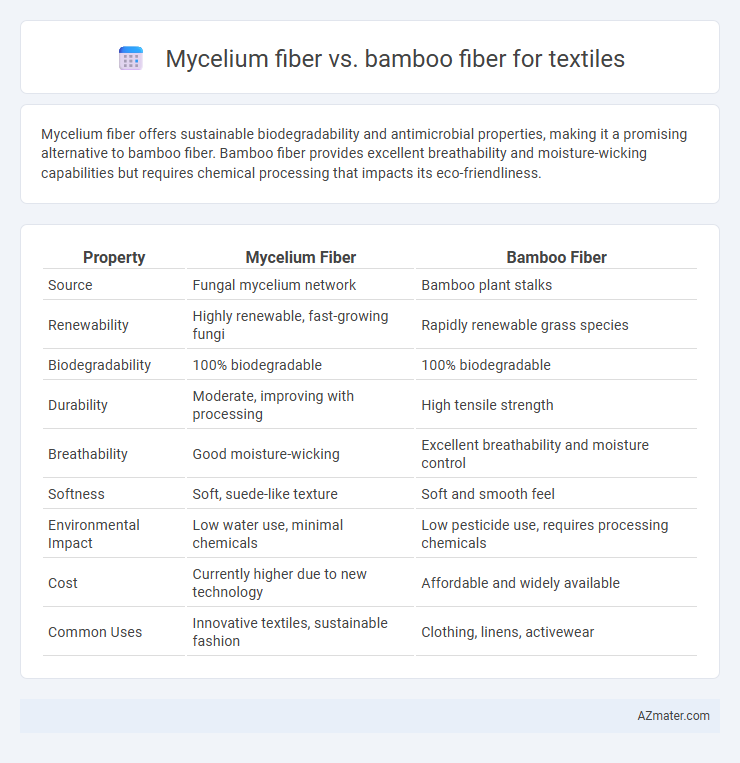Mycelium fiber offers sustainable biodegradability and antimicrobial properties, making it a promising alternative to bamboo fiber. Bamboo fiber provides excellent breathability and moisture-wicking capabilities but requires chemical processing that impacts its eco-friendliness.
Table of Comparison
| Property | Mycelium Fiber | Bamboo Fiber |
|---|---|---|
| Source | Fungal mycelium network | Bamboo plant stalks |
| Renewability | Highly renewable, fast-growing fungi | Rapidly renewable grass species |
| Biodegradability | 100% biodegradable | 100% biodegradable |
| Durability | Moderate, improving with processing | High tensile strength |
| Breathability | Good moisture-wicking | Excellent breathability and moisture control |
| Softness | Soft, suede-like texture | Soft and smooth feel |
| Environmental Impact | Low water use, minimal chemicals | Low pesticide use, requires processing chemicals |
| Cost | Currently higher due to new technology | Affordable and widely available |
| Common Uses | Innovative textiles, sustainable fashion | Clothing, linens, activewear |
Introduction: Mycelium Fiber and Bamboo Fiber in Textiles
Mycelium fiber, derived from the root structure of fungi, offers a sustainable and biodegradable alternative to traditional textile materials, boasting natural antimicrobial properties and lightweight durability. Bamboo fiber, extracted from bamboo plants, is known for its breathability, moisture-wicking capabilities, and rapid renewable growth, making it an eco-friendly choice with softness comparable to cotton. Both fibers are gaining traction in the textile industry for their environmental benefits and versatile applications in apparel and home textiles.
Overview of Mycelium Fiber
Mycelium fiber, derived from the root structure of fungi, offers a sustainable alternative to traditional textile materials due to its biodegradability and low environmental impact. Enhanced by its natural breathability, antibacterial properties, and ability to be grown using agricultural waste, mycelium fiber supports eco-friendly fashion and technical textiles. Compared to bamboo fiber, which is also sustainable but often requires chemical processing, mycelium fiber presents a more innovative and potentially less resource-intensive option for sustainable fabric production.
Overview of Bamboo Fiber
Bamboo fiber, derived from the pulp of bamboo plants, is renowned for its natural antibacterial properties, moisture-wicking abilities, and biodegradability, making it a popular choice for sustainable textiles. In comparison to mycelium fiber, bamboo fiber offers a softer texture and greater durability, ideal for producing breathable, eco-friendly fabrics used in clothing and home textiles. Its rapid growth and minimal pesticide requirements further enhance its appeal as an environmentally responsible material in the textile industry.
Production Process Comparison
Mycelium fiber production relies on cultivating fungal mycelium under controlled conditions, where the biomass is harvested, processed, and transformed into a soft, leather-like textile with minimal resource input and low water usage. Bamboo fiber production involves mechanical or chemical processing of bamboo stalks, where mechanical methods clean and crush fibers for eco-friendly linen-like fabric, while chemical methods use solvents to extract viscose rayon, often raising environmental concerns. Comparing both, mycelium fiber offers a more sustainable, low-impact production process with faster growth cycles, whereas bamboo fiber varies in environmental impact depending on the extraction technique employed.
Environmental Impact
Mycelium fiber and bamboo fiber both offer sustainable alternatives to conventional textiles, with mycelium fiber showing a lower environmental footprint due to its rapid biodegradability and minimal water usage in production. Bamboo fiber, while renewable and naturally pest-resistant, often involves intensive chemical processing that can generate pollution and higher water consumption. Choosing mycelium fiber supports reduced greenhouse gas emissions and less soil degradation compared to bamboo textile manufacturing.
Material Properties and Performance
Mycelium fiber offers exceptional biodegradability and natural antimicrobial properties, making it a sustainable alternative to conventional textiles with enhanced durability and moisture-wicking capabilities. Bamboo fiber excels in softness, breathability, and UV protection, attributed to its cellulose-rich composition, while also providing excellent tensile strength and quick-drying performance. Both fibers exhibit inherent antibacterial qualities, but Mycelium's unique mycelial network structure contributes superior structural resilience under varied environmental conditions compared to bamboo fiber.
Applications in the Textile Industry
Mycelium fiber offers innovative sustainability advantages in textiles, serving as a biodegradable alternative ideal for eco-friendly apparel, accessories, and upholstery. Bamboo fiber is widely utilized for its natural softness, breathability, and antibacterial properties, making it suitable for activewear, towels, and bedding products. Both fibers support the growing demand for sustainable textiles, with mycelium contributing to zero-waste manufacturing and bamboo providing moisture-wicking comfort in apparel.
Cost and Scalability
Mycelium fiber offers a cost-effective and sustainable alternative to traditional textiles, benefiting from low raw material expenses due to its cultivation on agricultural waste. Bamboo fiber production, while scalable due to established plantation infrastructure, often incurs higher costs related to chemical processing and water usage. Scaling mycelium fiber faces fewer environmental and resource limitations, presenting a more economically viable option for mass textile manufacturing compared to bamboo fiber.
Sustainability and Biodegradability
Mycelium fiber and bamboo fiber both offer sustainable alternatives for textiles, with mycelium derived from fungal networks requiring minimal water and land resources, while bamboo grows rapidly and naturally resists pests without pesticides. Biodegradability is a key advantage of both fibers: mycelium fiber decomposes quickly due to its organic fungal structure, whereas bamboo fiber breaks down efficiently, especially when processed mechanically rather than chemically. The environmental impact of mycelium fiber production tends to be lower overall, promoting circular economy principles, while bamboo fiber supports reforestation efforts and carbon sequestration through its fast growth cycles.
Future Prospects and Innovations
Mycelium fiber and bamboo fiber both showcase significant potential in sustainable textile innovation, with mycelium fiber offering rapid biodegradability and customizable texture through fungal network engineering. Bamboo fiber remains prominent due to its natural antibacterial properties and high tensile strength, making it ideal for durable, eco-friendly fabrics. Future advancements in mycelium fiber aim to enhance scalability and durability, while bamboo fiber innovations focus on chemical-free processing and blending with synthetic fibers for performance enhancement.

Infographic: Mycelium fiber vs Bamboo fiber for Textile
 azmater.com
azmater.com